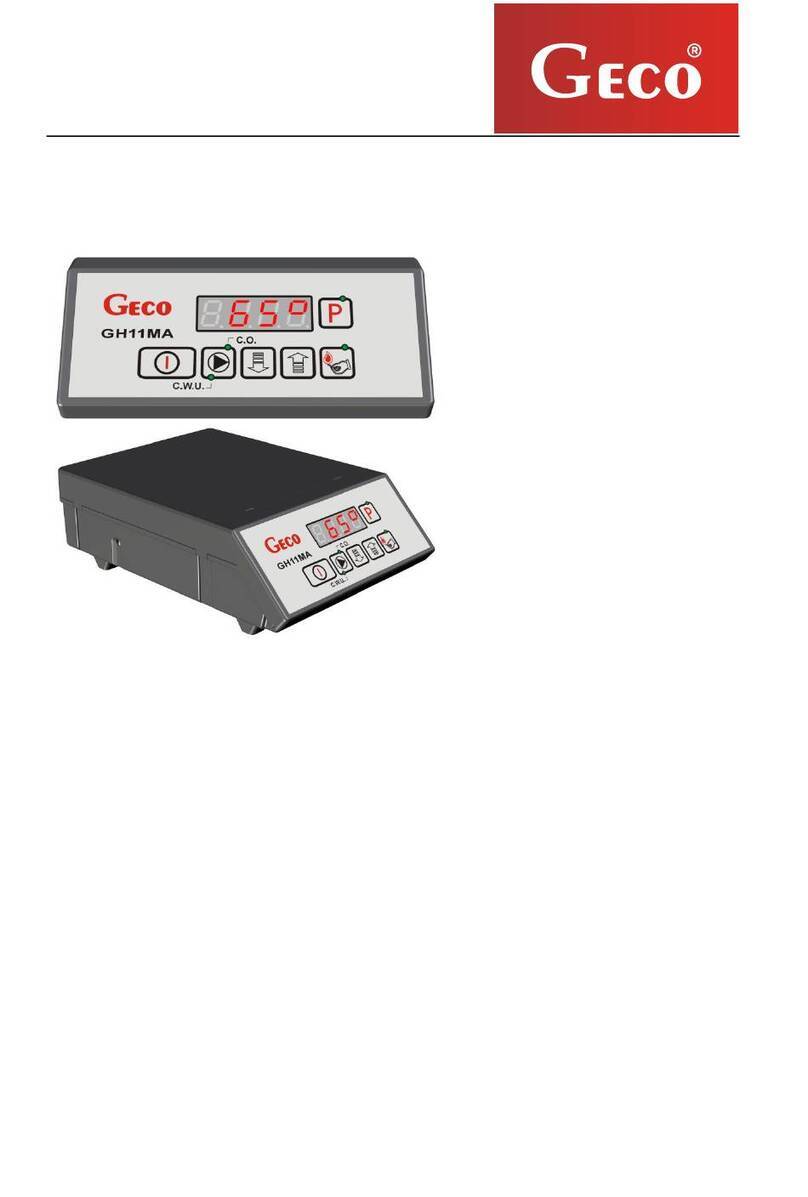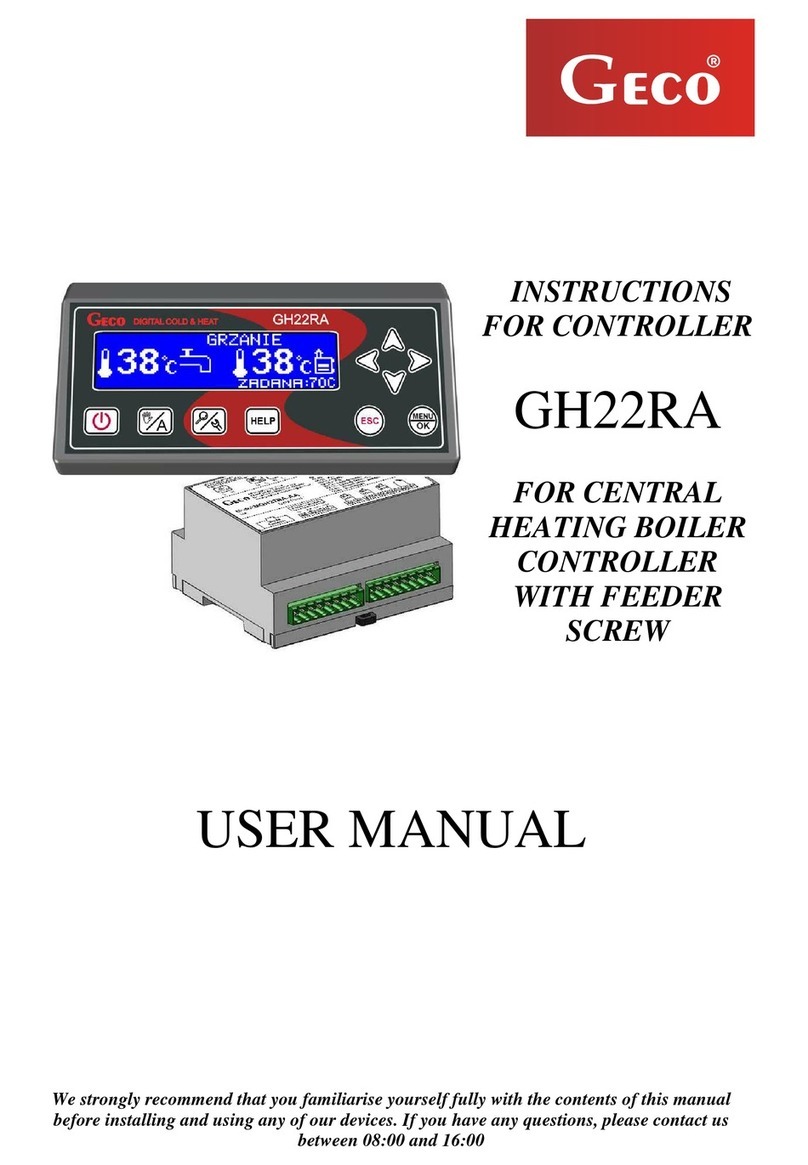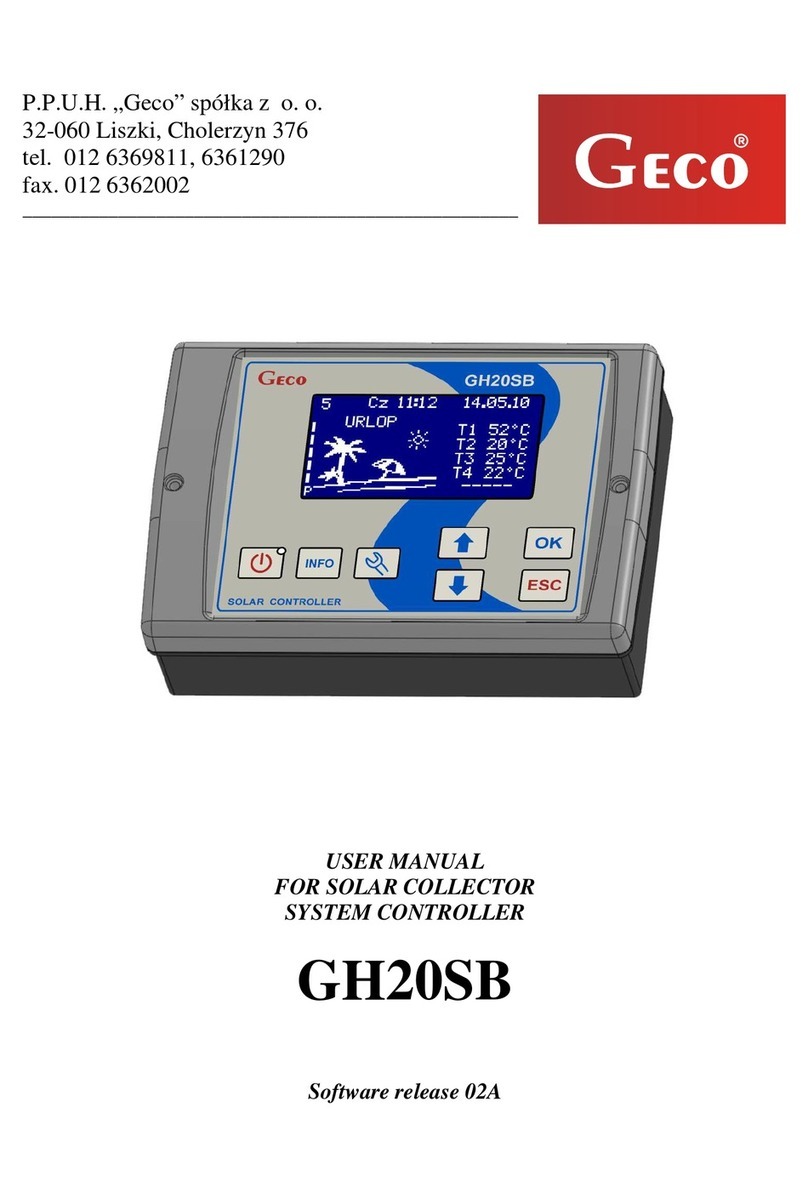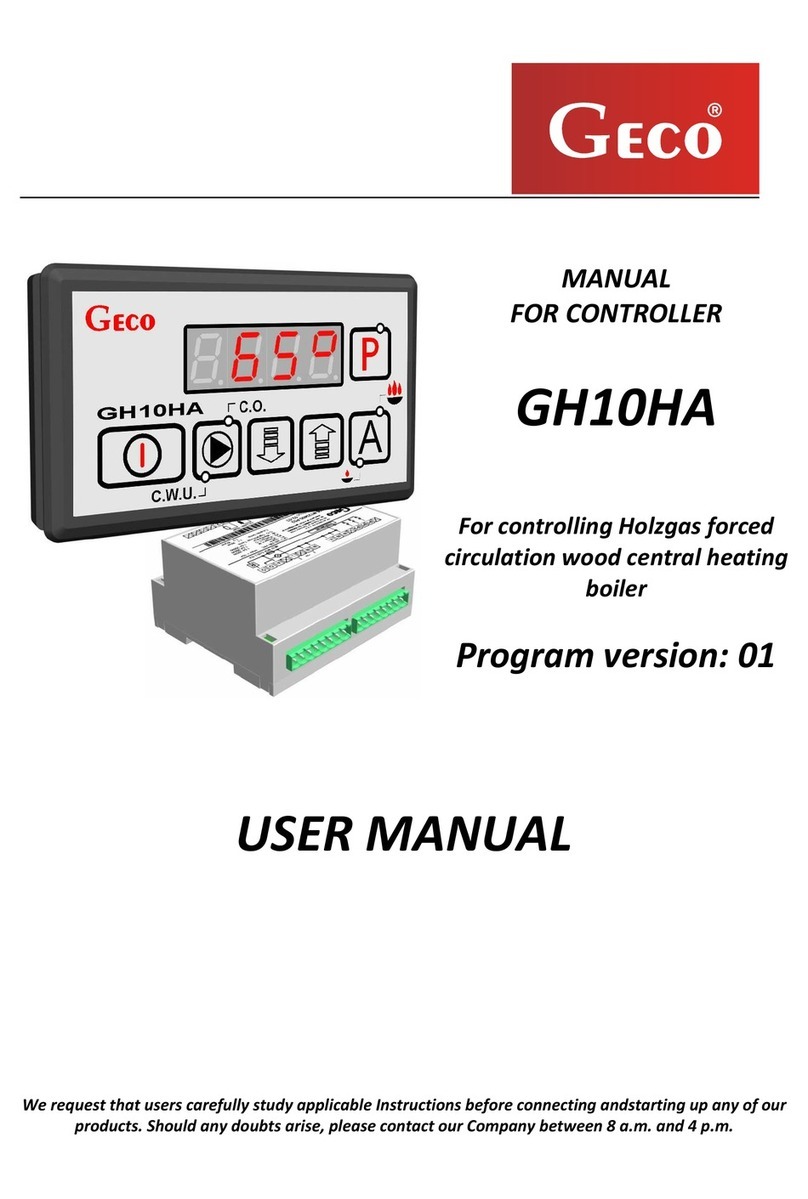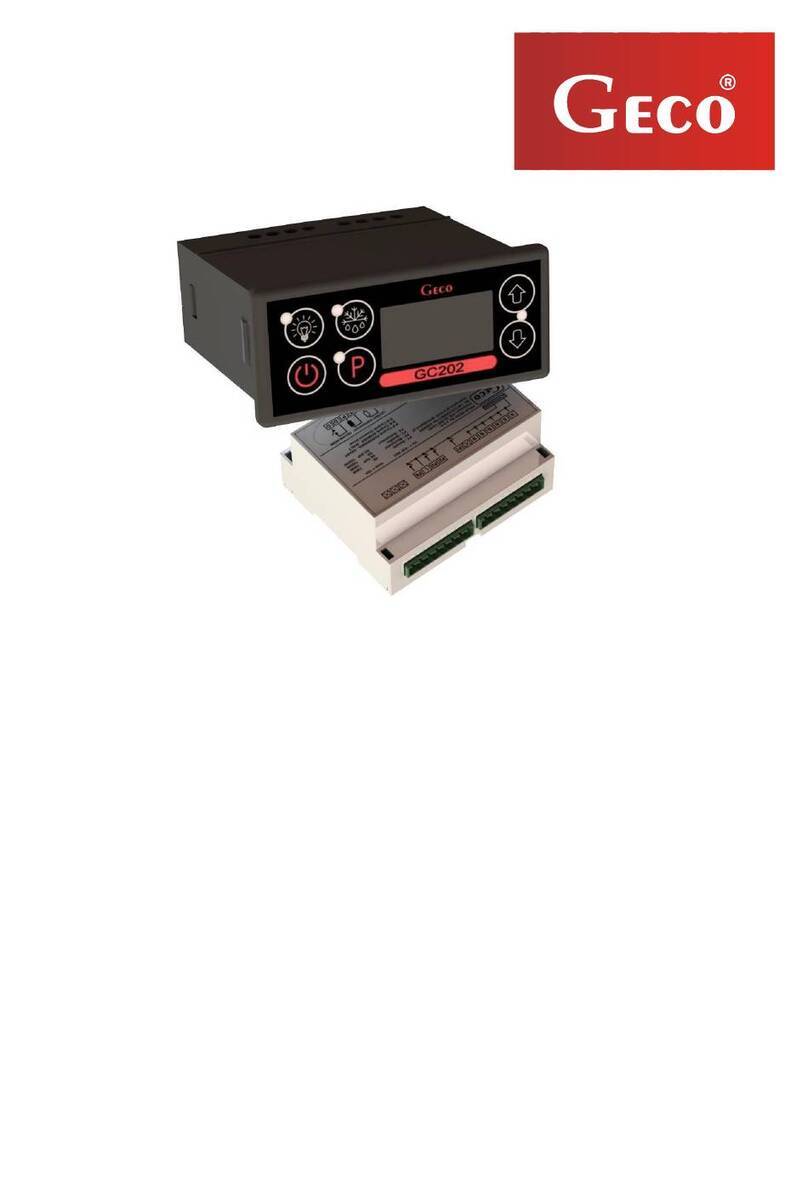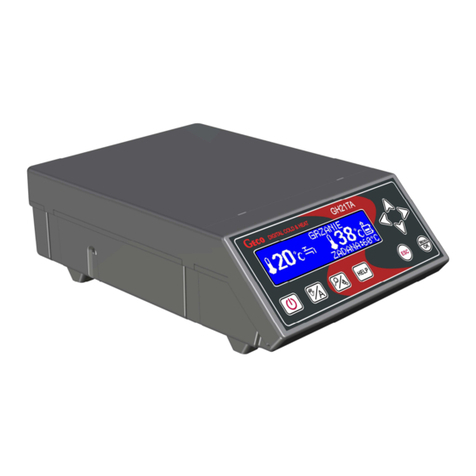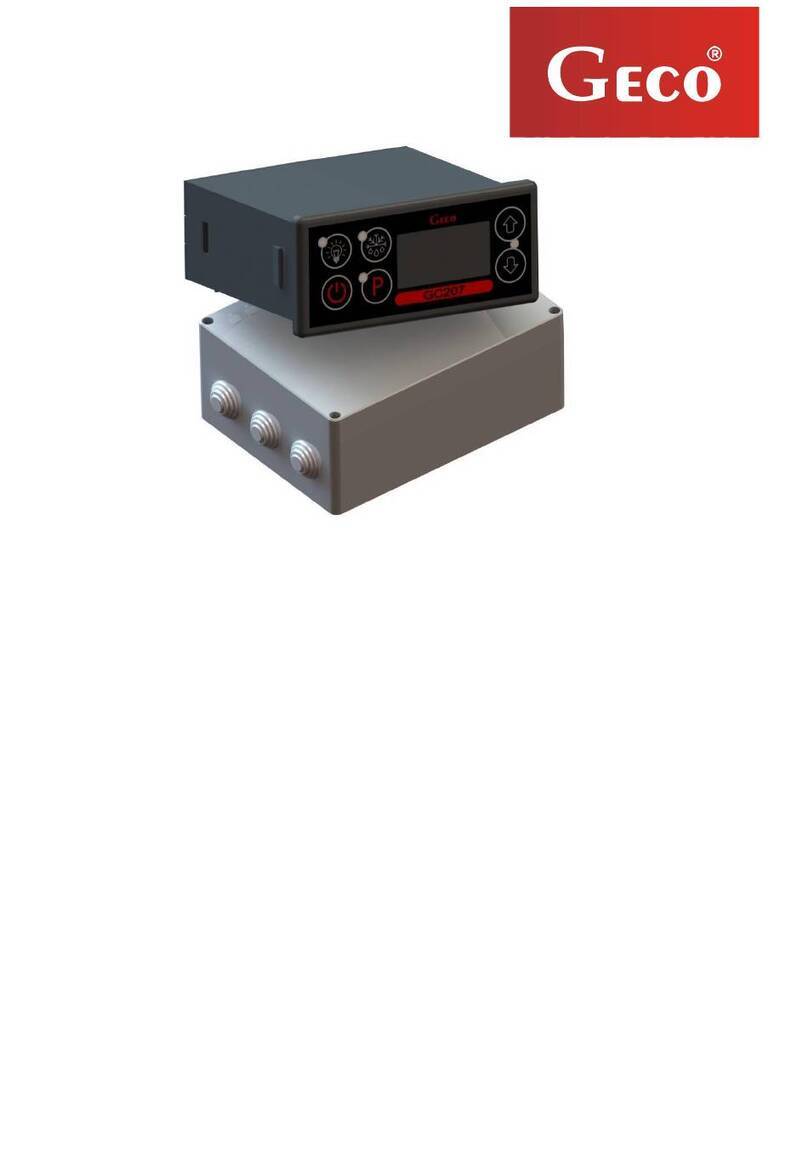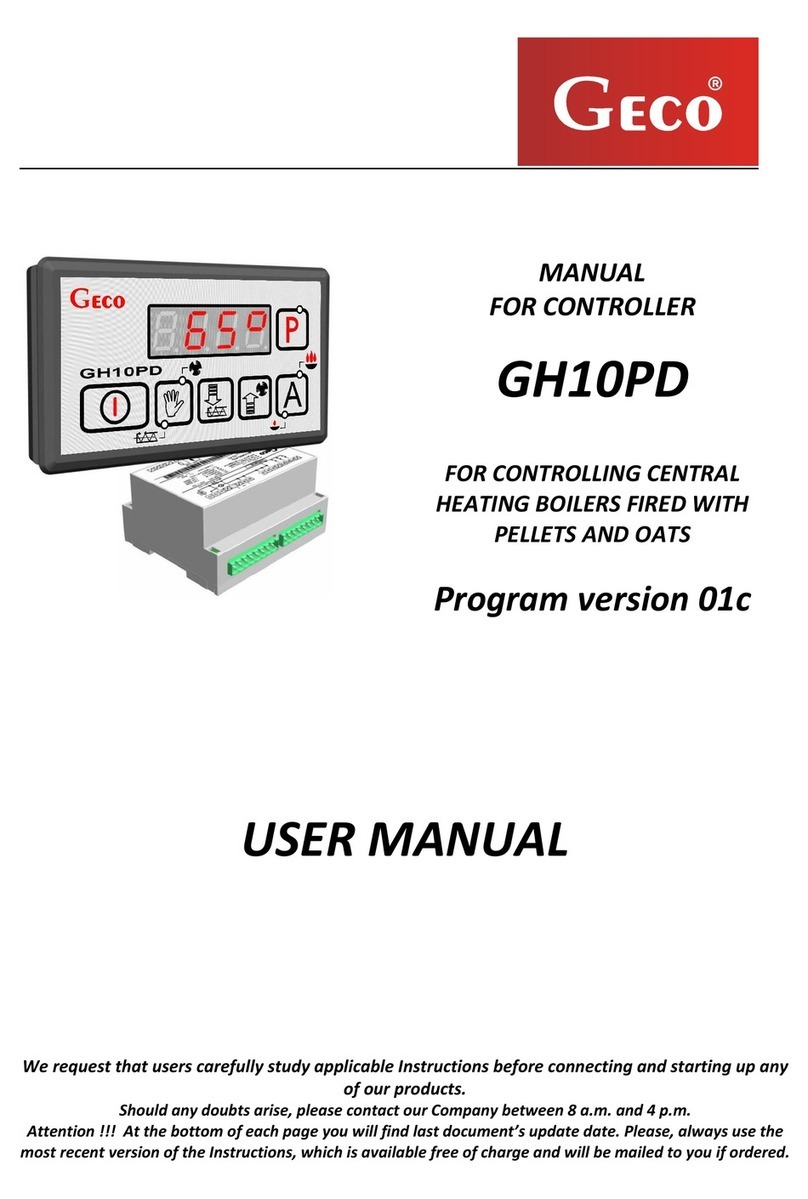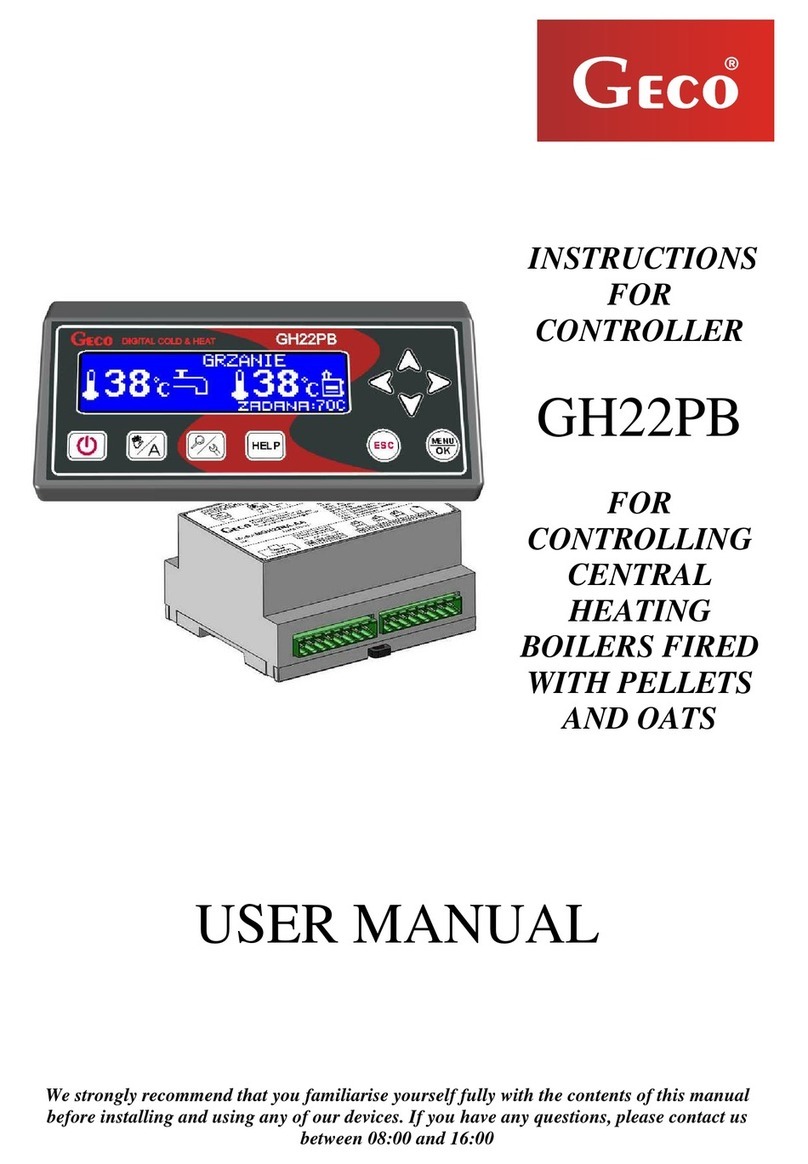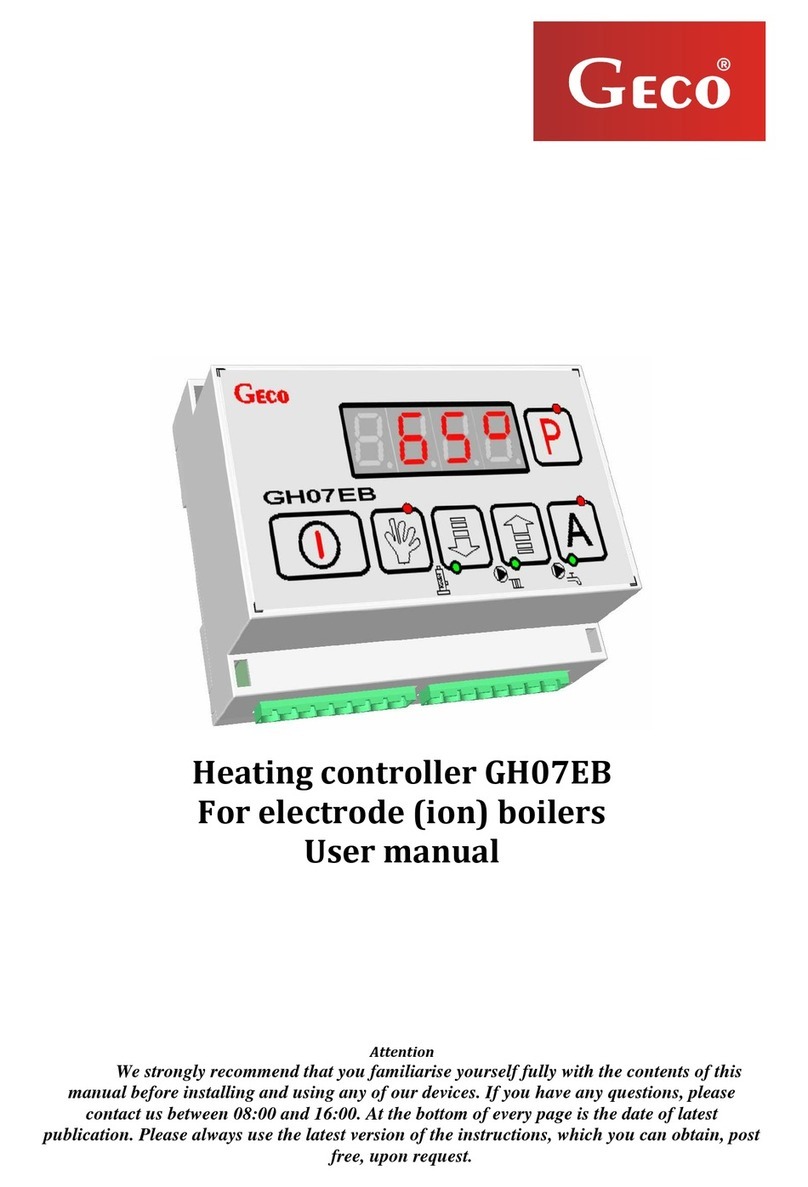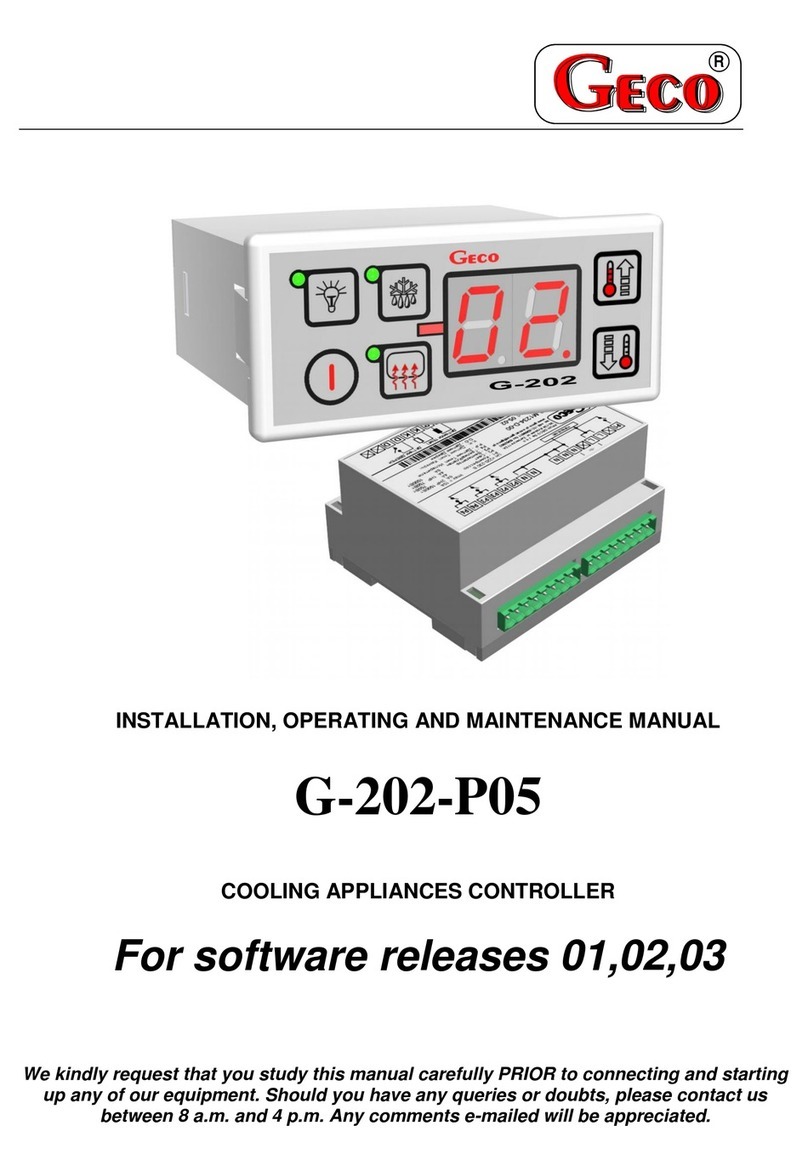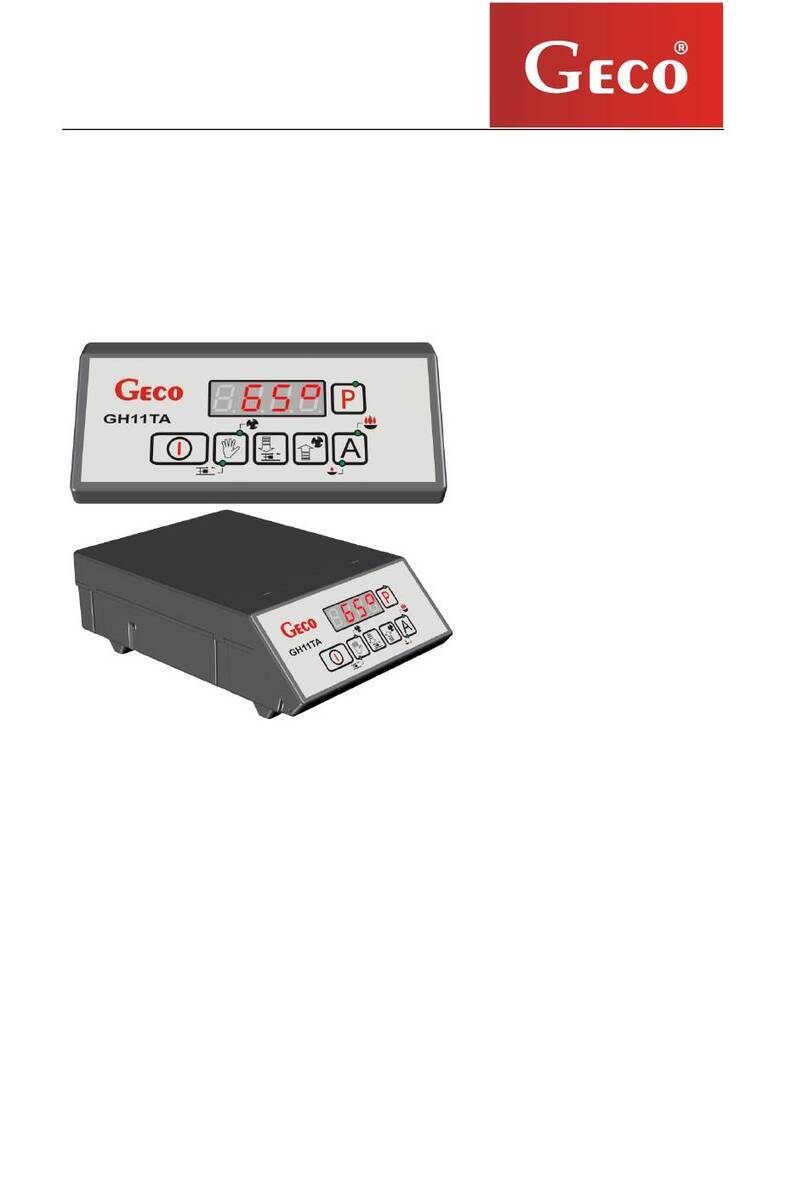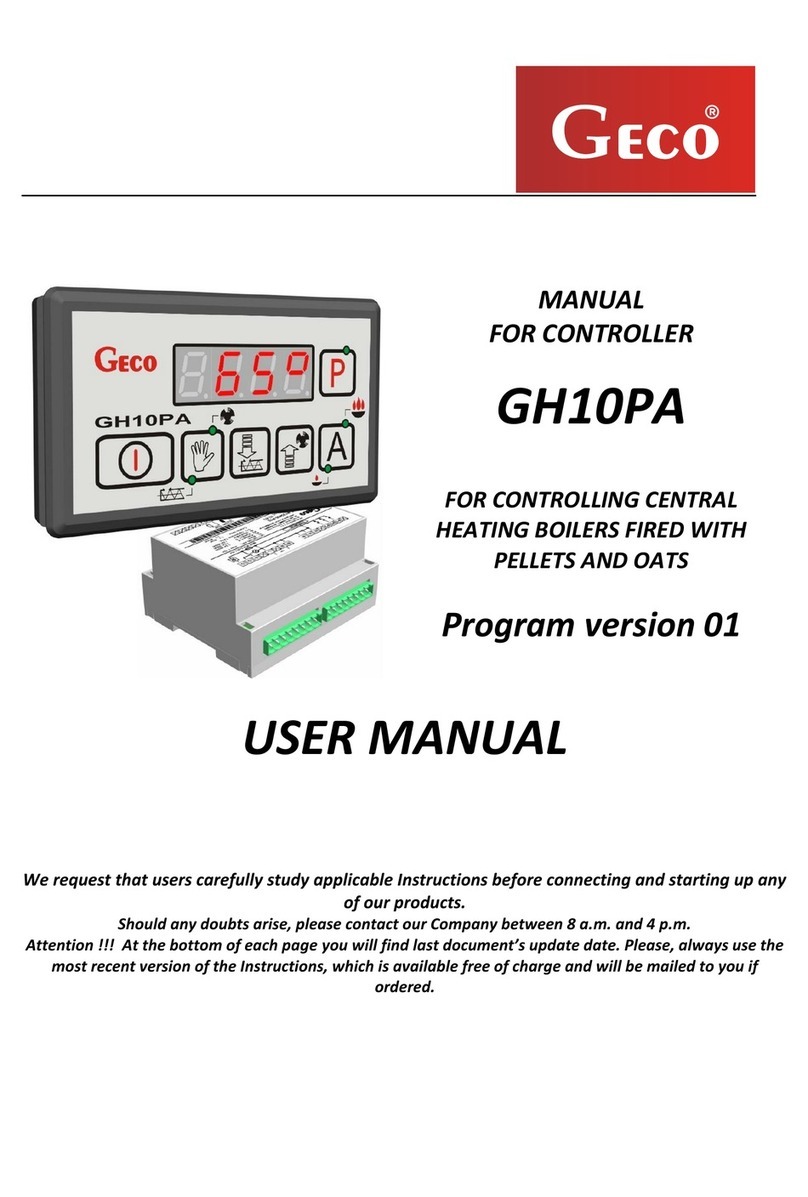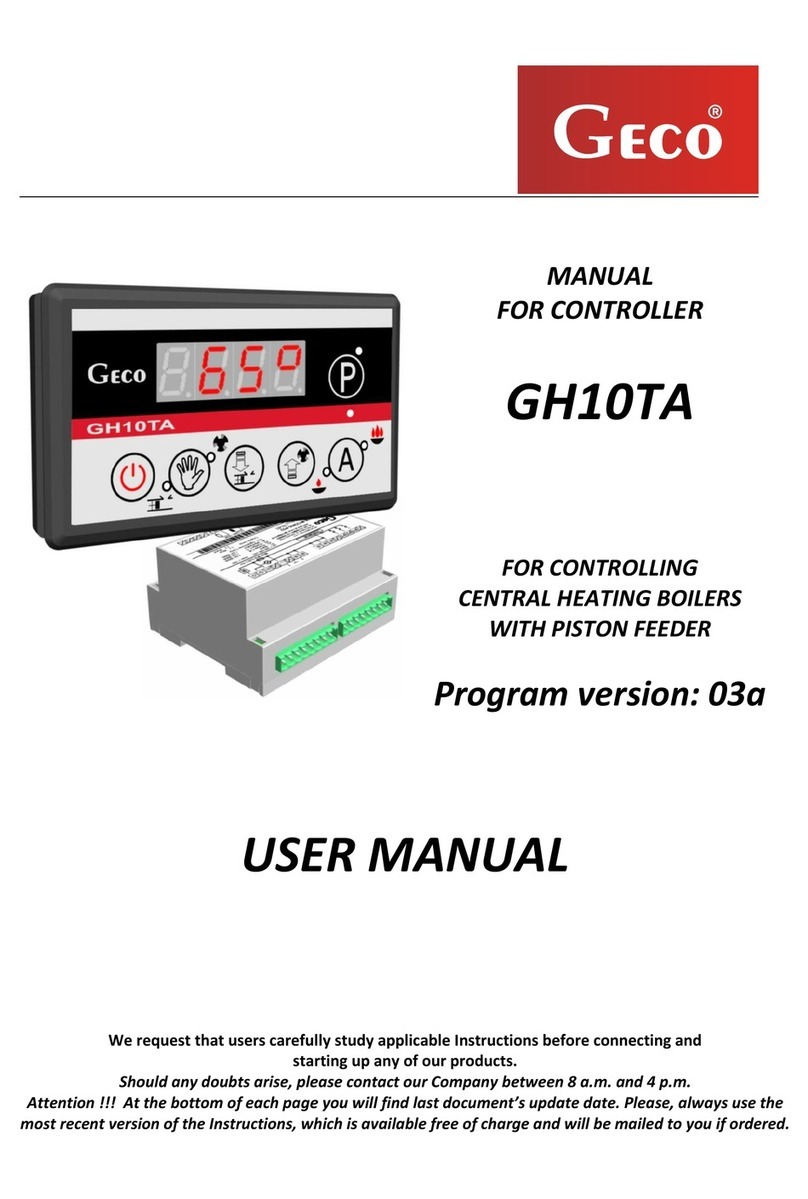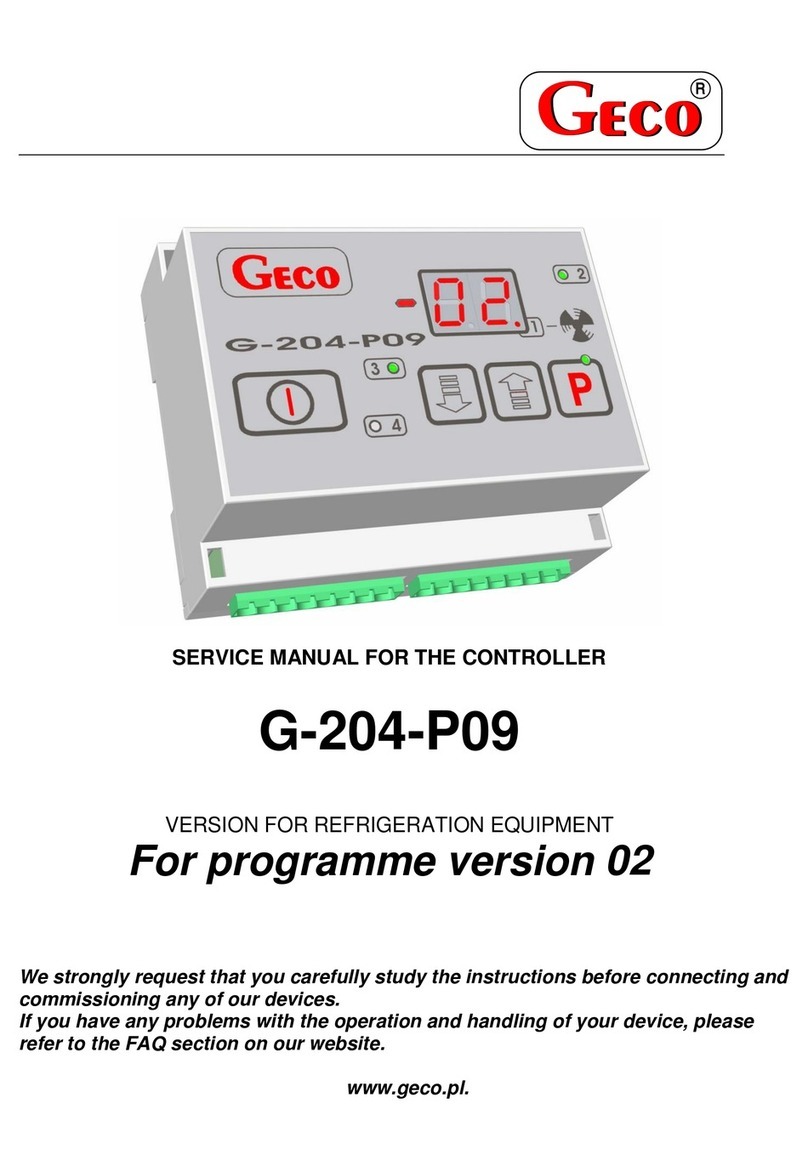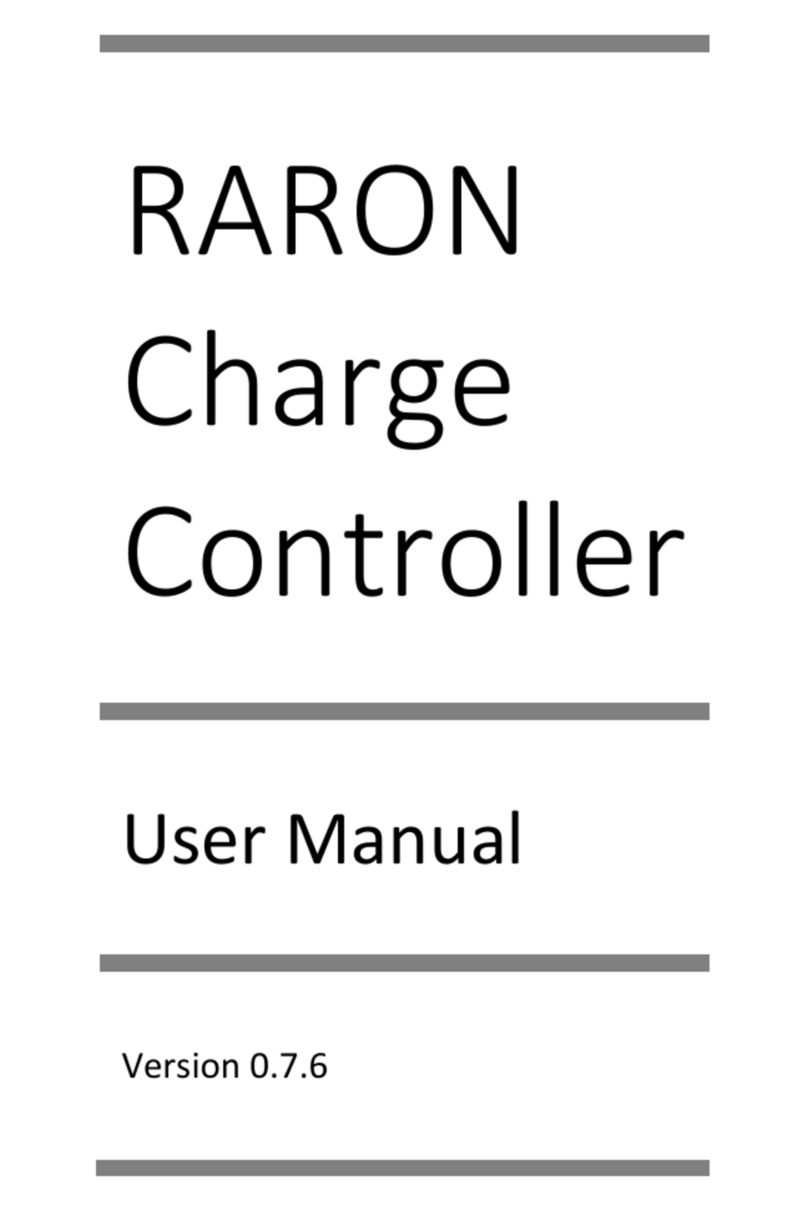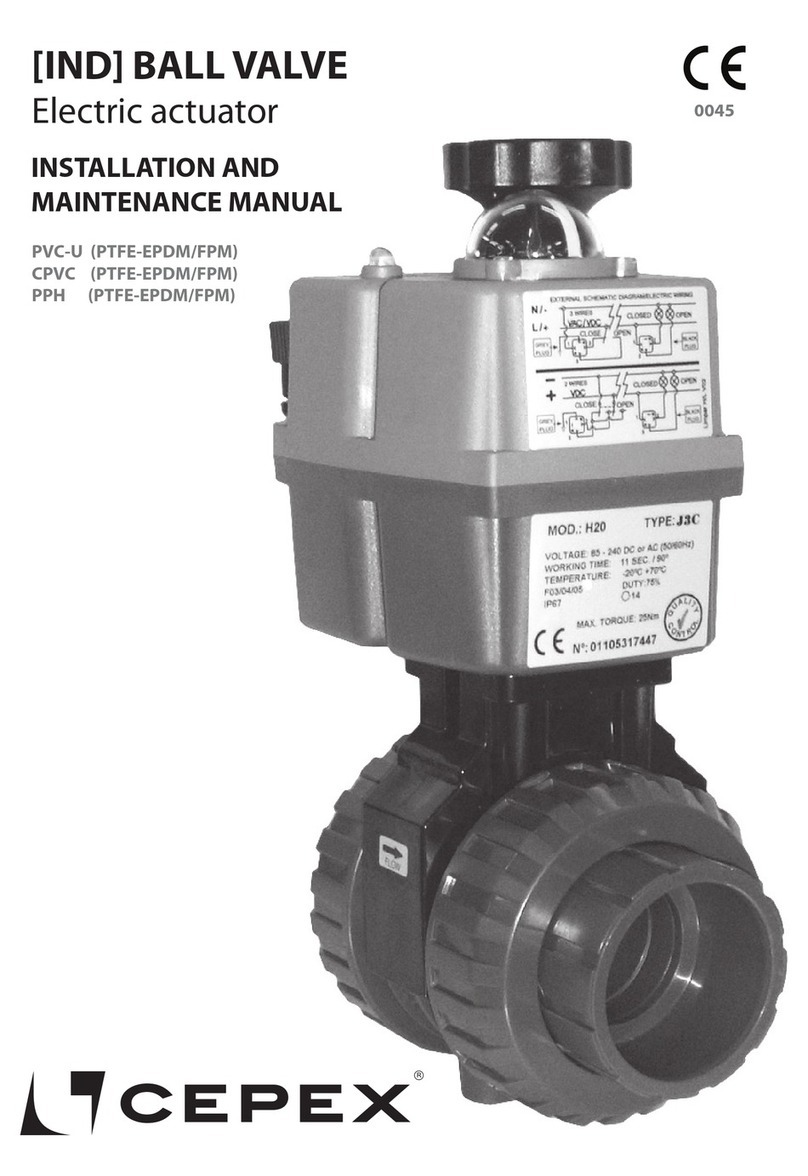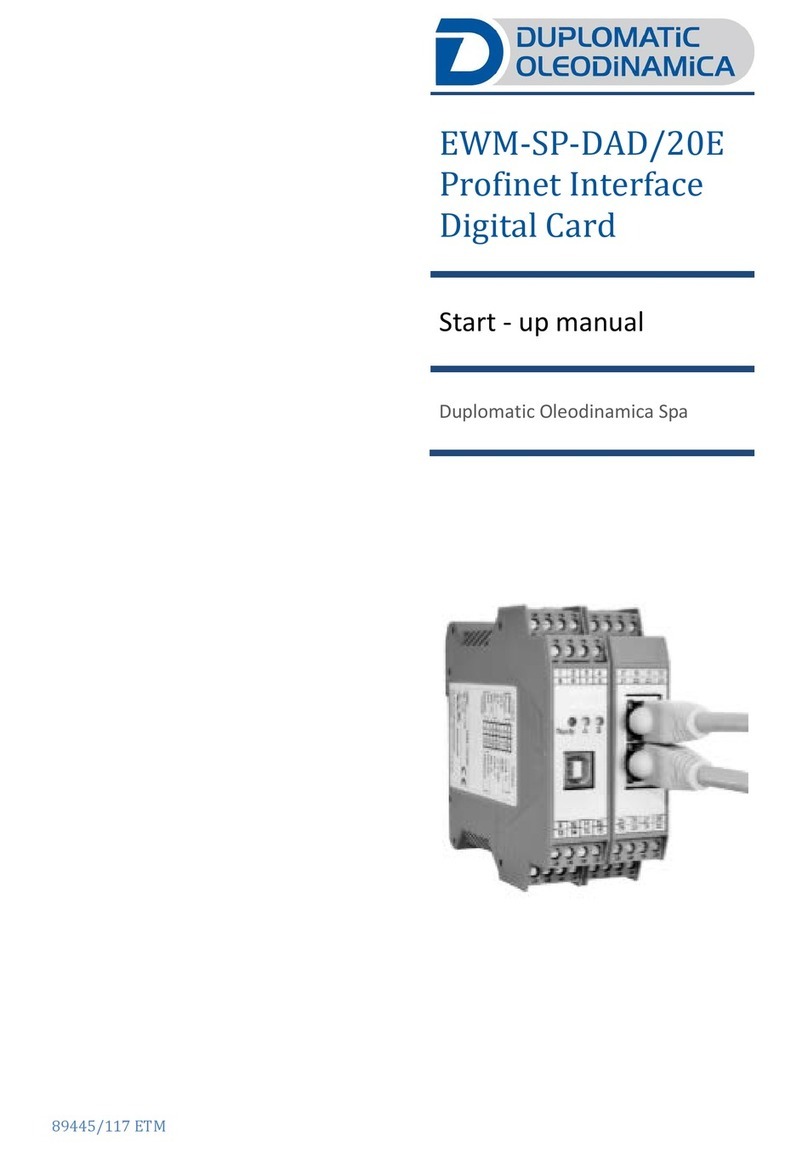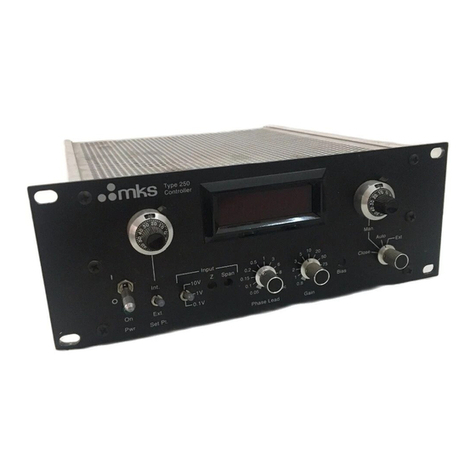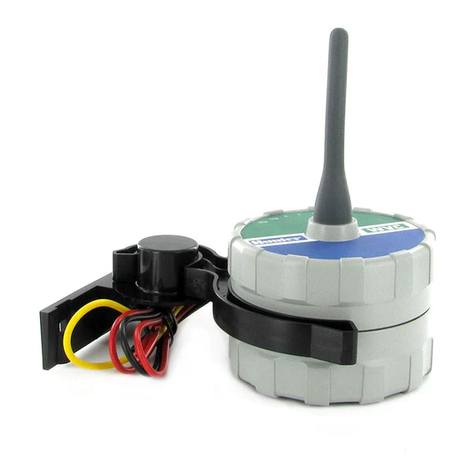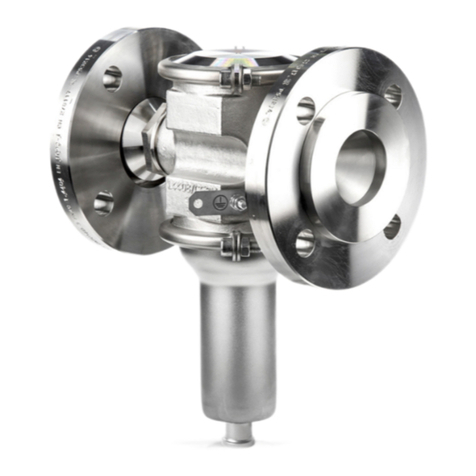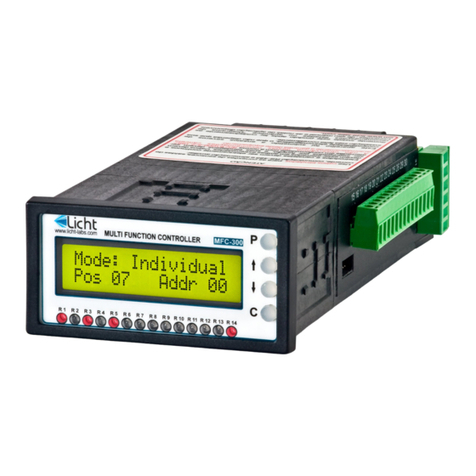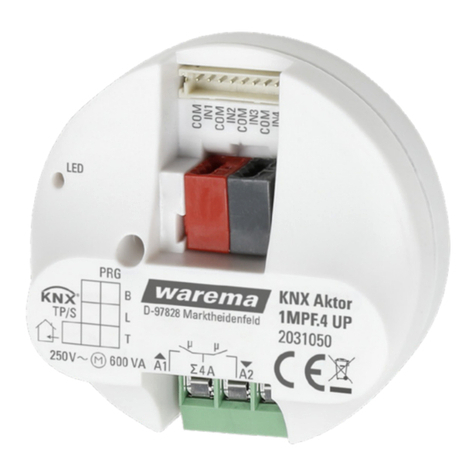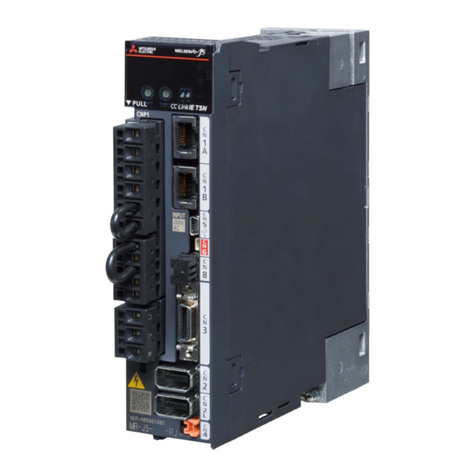Geco GC209 Installation guide

INSTALLATION, OPERATING AND MAINTENANCE
MANUAL
GC209
COOLING APPLIANCES CONTROLLER
For software version 01
Please, read the manual very carefully before connecting and starting any
of our devices.
In case of doubt please contact our company between 8am and 4pm.

Page 2
2nd edition
AS FROM 01.12.2017
Contents:
I.
GENERAL FEATURES ......................................................................................................................................................3
II.
MARKING AND SPECIFICATIONS....................................................................................................................................3
III.
HOW TO ORDER ............................................................................................................................................................4
IV.
GC209 ASSEMBLY AND CONNECTION............................................................................................................................4
V.
SENSOR MOUNTING RULES .................................................................................................................................................5
VI.
MODE OF OPERATION .........................................................................................................................................................6
A–GENERAL INFORMATION..................................................................................................................................................................................................6
1.
Start after power on ........................................................................................................................................................6
2.
Button functions ..............................................................................................................................................................6
3.
Temperature setting programming ................................................................................................................................. 7
4.
Compressor operation indication .................................................................................................................................... 7
5.
Compressor protection .................................................................................................................................................... 7
6.
Sensor alarms –A1 and A2 ......................................................................................................................................... 7
7.
Overheating alarm –A4.............................................................................................................................................. 8
8.
Temperature view .......................................................................................................................................................8
B–DEFROSTING............................................................................................................................................................................ 8
C–HYSTERESIS ............................................................................................................................................................................. 9
VII.
DIAGRAMS FOR CONNECTING INDIVIDUAL ASSEMBLIES OF THE DEVICE .......................................................................10
VIII.
SETTING THE SYSTEM PARAMETERS .................................................................................................................................11
IX.
TROUBLESHOOTING ....................................................................................................................................................13
X.
RETURNING FOR REPAIR .............................................................................................................................................14
XI.
METHOD OF CONNECTING DEVICES TO THE CONTROLLER ..........................................................................................15
XII.
INFORMATION ON MARKING AND COLLECTING WASTE ELECTRICAL AND ELECTRONIC EQUIPMENT .........................17

Page 3
2nd edition
AS FROM 01.12.2017
I. GENERAL FEATURES
The Standalone Control Block (SBR) GC209 is a modern, convenient and easy-to-use device. The Controller
is a microprocessor-based device manufactured using Surface Mount Technology (SMT).
The GC209 stabilises temperature and controls automatic defrosting with interval adjustable to ambient
condition. It also has a button to defrost the evaporator manually.
GC209 has offers a choice of operating modes with one or two temperature sensors and has two relay
outputs enabling direct connection of devices operating at 230V with the load capacity of the outputs in
accordance with Table 1.
As standard, the controller is equipped with sound signalling which is activated when any button on the
keypad is pressed and when an alarm goes off.
In order to provide the user with the comfort of using the controller, capacitive (touch) buttons have been
used in the keypad.
This regulator does not require any special maintenance; the keypad is made of plexiglass resistant to high
temperatures and most agents. It is not allowed to clean it with sharp objects. It is enough to wipe the front panel
with a damp cloth from time to time.
II. MARKING AND SPECIFICATIONS
Model designation: GC209.0X
0X –number denoting the controller version
01 –two-relay controller with the possibility of configuring the device connected to the second relay
in the following range: heater/fan/valve. The keypad of the controller panel is made without the light
button.
02 –two-relay controller with the possibility of configuring the device connected to the second relay
in the following range: light/heater/fan/valve. At the same time, this is a version dedicated to those
users who want to use a second relay to control the light. The keypad of the controller panel is made
with a light button.
Operating voltage
230V +10% -15%
Operating
temperatures
+5ºC to +40ºC
Relative humidity
20% to 80% RH
Ingress protection
IP65 at the front of the control panel

Page 4
2nd edition
AS FROM 01.12.2017
Table 1: Designation of relays and output loads
Output
Load
Ia
Ib
P
P1 –Compressor
R30A
8A
cos φ > 0.85
2HP
1500W
P2 –Universal
R16A
4A
-
800W
Ia –Relay rated current.
Ib –Load rated current.
P –Load rated power.
ATTENTION !!!
The total current consumed simultaneously by the devices
must not exceed 12A!!!
III. HOW TO ORDER
When ordering, specify the full name of the controller, according to the designation described in chapter II and the
length of the temperature sensors. Standard sensor lengths are 2.5m and 3.0m.
The following versions of regulators are available:
GC209.01 Thermostat controlling the operation of the compressor and the additional device (heater
or fan or valve);
GC209.02 Thermostat controlling the operation of the compressor and the additional device –mainly
lighting or the heater or fan or valve.
IV. GC209 INSTALLATION AND CONNECTION
1. Cut a hole measuring 57x109mm in the designated place in the device.
2. Any metal elements through which the GC209 or its cables are passed should be filed down or otherwise
secured. It is not permitted to mount the GC209 allowing the direct impact of water on it (e.g. water
condensing on the lower cover of the display case), touching the evaporator drain pipe, etc. and causing
significant changes in its temperature in relation to the ambient temperature (e.g. mounting in the immediate
vicinity of the compressor and its accessories, cooled and heated elements).
3. After mounting the GC209, connect the power cables in accordance with the description on the housing.

Page 5
2nd edition
AS FROM 01.12.2017
4. The connectors used are certified for a continuous load of 16A!!! They use a fine-pitch thread and special
plates to prevent cutting wires, so even a slight tightening results in maximum good contact, and the use of
greater force can lead to thread breakage. As a result, the socket may melt and a short-circuit may occur!!!
5. All cable surpluses are shortened by cutting or rolling and fastening them with special plastic ties. The cables
must be securely fastened along their entire length and must not touch the compressor and its accessories.
6. After connecting the device to the power supply, there may be voltage on the lighting cable, regardless of
switching the device on or off with the button, therefore the starter or fluorescent lamp can be
replaced only with the power cord disconnected from the socket!!!
THE SAME CONDITION APPLIES TO ANY OTHER REPAIRS!!!
7. If heaters are used, their power must be selected so that in the event of failure of the GC209 or external
contactor and switching them on permanently, there is no possibility of fire or destruction of the device. If
high-power heaters are used, it is absolutely necessary to use a safety thermostat on the evaporator. This
thermostat should operate differently, e.g. a mechanical thermostat.
V. SENSOR MOUNTING RULES.
1. For each type of manufactured refrigeration device, the place of mounting the chamber and evaporator
sensor, as well as the GC209 system parameters should be selected experimentally. It is absolutely forbidden
to change the place or method of mounting the sensors and GC209 settings without conducting new tests
regarding temperature stabilisation and defrosting of the device!!!
2. The chamber sensor must be attached in such a way that it does not touch the food and is not exposed to
damage while cleaning the device. A special plastic holder can be used to attach this sensor. This solution
causes a quick reaction in the sensor (time delays on/off, see VI p.5) and the entire thermostat to the change
of air temperature in the device. If it is advisable or necessary to slow down and “smooth” the reaction time
of the sensor to temperature changes, we suggest screwing it to a metal element of the device.
3. The evaporator sensor should be mounted in a way that ensures maximum solid and reliable contact with
the evaporator lamella and in such a place where the ice stays the longest during defrosting. Its attachment
should prevent it from being pushed out by accreting ice. Sensors should be mounted vertically, if possible,
with the cable coming out at the bottom of the sensor.
4. The sensor cables can be shortened or extended in any way, however, observing the following rules:
-do not cut the sensor cable at a distance of less than 0.5m from the shell
-it is not recommended to extend the sensor cable beyond 20m.

Page 6
2nd edition
AS FROM 01.12.2017
-THE WAY OF CONNECTING THE SENSOR CABLES TO THE SENSOR TERMINALS OF THE ACTUATOR MODULE IS
FREE!!! (similar to the method of inserting the plug into the ~230V socket)
-to extend the cables, we suggest using an OMY 2x0.5mm cable
-connection of the cables in the case of extensions should be done very carefully, each of the pairs of wires
is soldered and heat-shrinkable sleeves are put on them. Then, the connection point should be flooded
with waterproof silicone and another heat-shrinkable sleeve should be clamped on it.
-ends of the wires connected to S.B.R. should be tinned.
VI. GENERAL OPERATION PRINCIPLES
A –General information
1. Start after power on
After connecting power supply the device performs a 3-second initialising procedure during which the
display shows two dots for a second, controller software release for another second, and two dots again.
During that time none of the connected appliances are switched.
If the device was turned on before the power failure, after the start-up procedure is completed, the
device is turned on and the display shows the temperature value from the chamber sensor.
If it was off, it stays off and two horizontal lines appear on the display.
2. Button functions
Pressing and holding for 5s turns the controller on/off. The off state is signalled by two horizontal lines
on the display.
Pressing turns the lighting on or off. This is signalled by a green LED next to the button.
The button works independently of the thermostat switch –.
This is used to activate defrosting manually.
–is used to enable setting programming and to end programming.
–it is used to increase the preset temperature during programming and to enable the preview of the
evaporator temperature, if the evaporator sensor is supported, that is r2 = 0 (to activate the preview,
press the button longer).
–it is used to decrease the preset temperature during programming and to activate the preview of the
chamber temperature during defrosting (to activate the preview, hold the button longer). Clears
alarms and messages.

Page 7
2nd edition
AS FROM 01.12.2017
3. Programming the temperature setting:
After pressing the button, the programming mode is entered, the display shows the setting value and
the LED next to the button lights up.
Pressing or changes the setting value in the range of 'd0' to 'd1'.
Pressing saves the settings and the controller returns to normal operation.
If the GC209 is turned off during the programming mode, the new temperature setting will not be stored.
4. Compressor operation indication
Compressor activation is indicated by lighting of a small red diode (dot) in the lower right corner of the
temperature display. This allows easier checking of possible system malfunctions.
Should the compressor be switched on, but it is not due to the activation of one of the protections (see
point 5), the dot indicating the compressor operation will blink. After the protection times-out, the dot lights
permanently and the compressor is switched on.
5. Compressor protection
The delay in switching on the compressor after reaching its activation temperature (temperature set by the
user minus the lower hysteresis value) is 30 seconds. If the temperature drops during that period, the system
re-checks if the 30-second condition has been exceeded. This is to protect the compressor from unnecessary
activation, for example, caused by putting goods in, draughts, etc.
Once the compressor has been turned off for the time set by parameter 'c2', the GC209 will prevent the
compressor from turning back on.
After any interruption in the power supply or its drop below 175V, the GC209 will prevent the compressor
from turning on again for the time set by the 'c2' parameter. However, if 'c2'=0min, protection continues for
60 seconds.
After switching on the device with the button, a 5-second delay in compressor activation occurs.
Note that this will cancel all other protections. This allows quicker checking of the compressor operation.
6. Sensor alarms –A1 and A2
The Controller is equipped with alarms indicating sensor failures. Damage to the sensor is signalled by the
appearance of a relevant message on the display along with a beep.
Alarms and messages are displayed alternately with the temperature in the chamber. If the A1 alarm occurs, it
is displayed instead of the chamber temperature.
A1 –Damage to the chamber temperature sensor. GC209 will turn on the compressor in a time cycle (so-
called timer control) according to the times specified in the 'c8' and 'c9’ parameters. Defrosting will operate
normally.

Page 8
2nd edition
AS FROM 01.12.2017
A2 –If parameter r2 = 0 and c0 ≠ -1 then the evaporator probe failure alarm will be signalled. In such case,
the operation of manual and automatic defrosting is blocked!!! If we change the parameter to r2 = 1, then
defrosting of the device will be carried out in time according to the setting of the 'c1' parameter.
After pressing any button, the alarm is silenced.
7. Overheating alarm –A4
If the temperature in the chamber is higher than the 'd6' parameter, the display shows alarm A4 alternately
with the temperature, and an audible alarm is generated. Pressing any button silences this alarm.
8. Viewing Temperatures
If r2 = 0, then after pressing and holding the button, the display will start flashing and show the
temperature of the evaporator, after another 5 seconds GC209 will automatically return to reading the
temperature from the chamber. Attention!!! This function also works during defrosting when 'dF' lights up on
the display. You can also see the temperature from the chamber sensor by pressing and holding the
button for a moment, the display will start showing (without blinking) the chamber temperature, after another
5 seconds GC209 will automatically return to the 'dF' display.
B –Defrosting
1. If additional defrosting is required due to difficult working conditions, press the button. The green diode
on the button will then be lit continuously and the display will show 'dF' instead of temperature reading.
This causes the appliance to enter the defrosting cycle.
2. If defrosting occurs and parameter r2 = 1, then the defrosting time is defined by parameter 'c1'.
If defrosting takes place, and parameter r2 = 0 and the temperature on the evaporator is higher than set in
the 'd2’ parameter, the device will enter the defrosting exit phase after about 10 seconds and after its
completion, it will resume operating.
If the defrosting function is active, and parameter r2 = 0 and the temperature on the evaporator is lower than
the 'd2’ parameter setting, the GC209 activates defrosting and when the 'd2’ temperature setting is reached,
the Controller enters the defrosting exit procedure (this condition is indicated by flashing of the green diode
on button) consisting of a single dripping phase –which the compressor remains off for the time set in
the 'c3' parameter.
If the 'c0' time has elapsed since the last defrosting activation, and the compressor is running at this moment,
the automatic defrosting activation will be delayed until the compressor is deactivated as a result of reaching
the set temperature or exceeding the maximum operating time specified by the 'c5' parameter (for c5≠0).
If the device cannot reach the set temperature, extend the maximum working time of the
compressor in the 'c5’ parameter.

Page 9
2nd edition
AS FROM 01.12.2017
½‘d3'
'd3'
½‘d3'+0.5ºC
½‘d3'
½‘d3'-0.5ºC
Switch on temp.
Switch off temp.
Temp. set by the
user
3. After switching off 'dF' and the end of defrosting, the display will show the temperature stored just before the
start of defrosting for the time specified in the 'c7' parameter –this is to prevent complaints due to “rapid
temperature jumps in the device”.
4. The system behaves in the same manner for manual and automatic defrosting.
C –Hysteresis
When programming the parameters 'd0' and 'd1' (minimum and maximum temperatures that can be set by the
user) you should also remember that the hysteresis value 'd3' causes additional “dragging” of the temperature
down and up from the value set by the user.
This is especially important in the case of devices maintaining positive temperatures, which should always work
above 0ºC.
Example:
As a manufacturer of a refrigeration device, in this case a cooling counter (positive temperatures), we require that
the device enabled operation be only within the range of temperatures that do not exceed the below specified
values: switch off min.: 20C, switch on max.: 100C.
Symmetrical hysteresis for even values of 'd3'
Asymmetric hysteresis for odd values of 'd3'
Example 1.
For example, the 'd3' hysteresis is set to 20C
For the above hysteresis setting you should also set
the parameters: 'd0' to 30C, and 'd1' to 90C
Example 3.
For example, the 'd3' hysteresis is set to 30C
For the above hysteresis setting you should also set
the parameters: 'd0' to 30C, a 'd1' to 80C
Example 2.
For example, the 'd3' hysteresis is set to 40C
For the above hysteresis setting you should also set
the parameters: 'd0' to 40C, a 'd1' to 80C
Example 4.
For example, the 'd3' hysteresis is set to 50C
For the above hysteresis setting you should also set
the parameters: 'd0' to 40C, a 'd1' to 70C
'd3'
Fig. 1 Hysteresis operation.

Page 10
2nd edition
AS FROM 01.12.2017
VII. ON/OFF DIAGRAMS FOR INDIVIDUAL ASSEMBLIES OF THE
APPLIANCE
A thick line means switching on, and a dashed line means switching off individual devices.
The “Downtime” field means switching off, and “Work” –switching on of the compressor due to exceeding the
programmed temperature, of course, taking into account the value of the programmed hysteresis, parameter
'd3'.
INCORRECT PARAMETER SETTING CAUSES ERRONEOUS OPERATION OF THE
APPLIANCE !!!
Fig. 2 Diagrams of switching on individual components of the device.
1. fan operating together with the compressor 'r1'=01,
2. fan running all the time 'r1'=02,
3. evaporator heater
'r1'=03,
COMPRESSOR
FAN
Stop
Work
DEFROSTIN
G
EXIT DEFROSTING
Work
Stop
t=0 (c3 irrelevant)
COMPRESSOR
FAN
Stop
Work
DEFROSTING
EXIT DEFROSTING
Work
Stop
COMPRESSOR
HEATER
Stop
Work
DEFROSTING
EXIT DEFROSTING
Work
Stop
4. tray heater 'r1'=04,
COMPRESSOR
TRAY HEATER
Stop
Work
DEFROSTING
EXIT DEFROSTING
Work
Stop
5. valve 'r1'=05,
COMPRESSOR
VALVE
Stop
Work
DEFROSTING
EXIT DEFROSTING
Work
Stop
t=0 (c3 irrelevant)

Page 11
2nd edition
AS FROM 01.12.2017
VIII. SETTING THE SYSTEM PARAMETERS
Once the device is started and checked for proper operation (default settings are factory set) you can begin to enter
the system parameters of the GC209.
To do this, turn off the device with the button (two horizontal lines will appear on the display). Then
press and hold the button for approx. 5 seconds. After that, the diode next to the button and
should start blinking, and the display will show 'c0' for one second. Then the previously set value for the
parameter will be shown. Now, use the and arrows to enter the desired settings; each longer holding of
the button will cause fast “scrolling” of indications. Then press to confirm the entered data and move on to
the next parameter.
Partial adjustments are possible. If you do not want to change a given setting, press and GC209 will go
to the next parameter.
After entering the setting of the last parameter and confirming it with the button, the programming
mode will be automatically exited and the STANDBY mode will return (two horizontal lines on the display).
If no button is pressed within 20 seconds, the device will exit the parameter programming mode.
ATTENTION !!!
Incorrect change of parameter settings may cause faulty operation of the
device!!!

Page 12
2nd edition
AS FROM 01.12.2017
Table 2: Designation of parameters
Paramet
er
Description
Min.
Max
.
Step
Factory setting
c0
How often defrosting should take place
00 –there will be no automatic defrosting, only manual defrosting!!!
-01 –will not defrost automatically or manually!!!
-01
24
1h
6h
c1
For r2=0, maximum defrosting time if the evaporator does not reach
the set temperature (d2 parameter); for r2=1 defrosting time not
determined by d2 parameter; Attention!!! If this parameter is set to “-
01”, there will be no time limit
-01
99
1min
30min
c2
Minimum compressor downtime duration
0
15
1min
3min
c3
Evaporator dripping duration
0
15
1min
2min
c5
Maximum compressor operation duration
0 –means there is no test (the parameter is disabled)
0
99
1min
40min
c6
Compressor downtime duration after activation of protection set in
parameter 'c5'
0
99
1min
10min
c7
Duration of showing the temperature measured just before the
defrosting, shown immediately after the defrosting (parameter 'c3').
0
60
1min
5min
c8
Compressor operation time when the control sensor is damaged
1
99
1min
25min
c9
Compressor downtime when the control sensor is damaged
1
60
1min
5min
d0
Minimum temperature the customer will be able to set
-40
20
1°C
1°C
d1
Maximum temperature that the customer will be able to set
d0+1
40
1°C
10°C
d2
Evaporator temperature at which the defrosting is finished
0
40
1°C
5°C
d3
Hysteresis value
1
10
1°C
2°C
d4
Value of the chamber sensor re-scaling from the actually measured
temperature
-10
10
1°C
0°C
d6
The temperature in the chamber, when exceeded, the alarm A4 is
activated.
-40
40
1°C
40°C
r0
Temperature sensor type:
00 –NTC 2.2k
01 –NTC 10k
00
01
1
00
r1
Device connected to the second relay:
00 –lighting
01 –fan operating together with the compressor
02 –fan operating continuously
03 –evaporator heater
04 –tray heater
05 –valve
00
04
1
00 (for
GC209.02
version)
01 (for
GC209.01
version)
r2
Evaporator sensor operation:
0–the sensor is supported
1–the sensor is blocked
00
01
1
00
r5
Conditions for defrosting activation during the device start:
00 –start of operation without defrosting
01 –if a power outage occurred during defrosting, defrosting is
activated
02 –defrosting after each switching of the device on.
00
02
1
00

Page 13
2nd edition
AS FROM 01.12.2017
IX. TROUBLESHOOTING
Table 3: Problems and methods of their elimination.
Symptoms
Checks
1. The display does
not light up even
though the GC209
is connected to the
mains
- presence of 230V voltage at the power supply terminals L and N
2. The compressor
does not turn on
despite signalling its
activation –red
diode
- presence of 230V voltage on terminals P2 and N –If present, check the
compressor
3. The
defrosting
heater does not
turn on
- presence of 230V voltage on terminals according to the description
on the top side of the executive module
- if it is, check the heater
4. Incorrect
temperature reading
- connecting sensors to connectors
- parameter value 'd4'
- parameter value 'r0'
- correct mounting of the sensor
- condition of the sensor cable –the cable must not have any damage
- Check the exact appearance of the outer surface of the sensor shell to
see if it has not been mechanically damaged.
5. It is not possible
to set the desired
temperature
value of 'd0' and 'd1' parameters (d0<d1)
6. Flashing dots on
display, no switching
on possible
- supply voltage value
- condition of power connectors
- tightening the power connectors
7. ‘Abnormal’,
‘strange’ behaviour of
the device
- the presence of 230V voltage on the L and N power terminals
- condition of power connectors
- zeroing of the refrigeration unit
- condition of the electrical installation and the number of devices connected
to one phase
- do you have the correct type of a thermostat (output label) for your device
- has the thermostat not been exposed to water or any other liquid
- is the thermostat not exposed to moisture or sudden changes in
temperature

Page 14
2nd edition
AS FROM 01.12.2017
8. Problems with
appliance
defrosting
- 'r2', 'd2' and 'c0', 'c1' parameter value
- value of the 'c1' parameter depends on the setting of the 'r2’ parameter.
This is the maximum defrosting time of the device for r2=0, regardless of
whether the evaporator has reached the programmed end of defrosting
temperature or not ('d2' parameter). If this duration is too short, the
appliance will not be able to defrost completely.
For r2=1, the defrosting time is not conditioned by the 'd2' parameter.
- correct mounting of the sensor to the lamellas of the evaporator.
IT MUST BE FIRMLY MOUNTED AND TIGHTLY ADHERE TO THE
LAMELLAS!!!
- is the evaporator sensor mounted in the place where the ice stays the
longest, if not, check the temperature on the sensor when the last ice
nuggets fall from the evaporator. THIS TEMPERATURE SHOULD BE
ENTERED THEN AS 'd2' PARAMETER
9. The appliance
does not reach its
set temperature
and its cooling
function is not
working
- what temperature has been set by the user
- settings of individual parameters, especially 'c2', 'c5', 'd0', 'd1'
- point 8 –Problems with defrosting the device. If the appliance does not
defrost completely, it will not reach its set temperature!!!
- method and place of attaching the chamber sensor
- have the side windows in the rack and the sliding windows in the
display case not been dismantled
- MAKE SURE THE DEVICE IS NOT POSITIONED IN A DRAFT OR IN THE
SUN!!!
- are there no fans or air conditioning installed on or near the ceiling
- condenser cleanliness
- temperature in the store (each manufacturer provides max.
operating temperature for the appliance)
- amount of gas, fans, evaporator heater, evaporator drain hose
X. RETURNING FOR REPAIR
PPUH GECO reserves the right to refuse to accept the device for free
repair if the seals are found to be broken!!!
P.P.U.H. Geco Sp. z o.o. is not liable for losses and damage
resulting from the fact that the manufacturer of the refrigeration
device or its service provided the final customer with information
on how to make changes to the GC209 system data, incorrect or
unprofessional installation, and for losses caused by malfunction of
the device.

Page 15
2nd edition
AS FROM 01.12.2017
XI. METHOD OF CONNECTING DEVICES TO THE CONTROLLER
Fig. 3 Diagram for connecting devices and sensors to the regulator model GC209.01, which does not have a button
to operate the lighting.
VIEW FROM ABOVE
EVAPORATOR sensor
CHAMBER sensor
Power supply
FRONT VIEW

Page 16
2nd edition
AS FROM 01.12.2017
Fig. 4 Diagram for connecting devices and sensors to the regulator model GC209.02, which is additionally
equipped with a lighting control button.
Power supply
EVAPORATOR sensor
CHAMBER
sensor
FRONT VIEW
VIEW FROM ABOVE

Page 17
2nd edition
AS FROM 01.12.2017
XII. INFORMATION REGARDING MARKING AND COLLECTION OF
WASTE ELECTRIC AND ELECTRONIC EQUIPMENT
ATTENTION!
The symbol placed on a product or on its packaging indicates that it is
subject to selective collection of waste electric and electronic equipment.
This means that the product should not be discarded with other household
waste. Appropriate removal of old and waste electric and electronic
equipment will prevent potentially harmful effects on the environment and
human health.
The obligation of selective equipment collection rests on the user who
should deliver the equipment to a collection point.


Table of contents
Other Geco Controllers manuals
Popular Controllers manuals by other brands
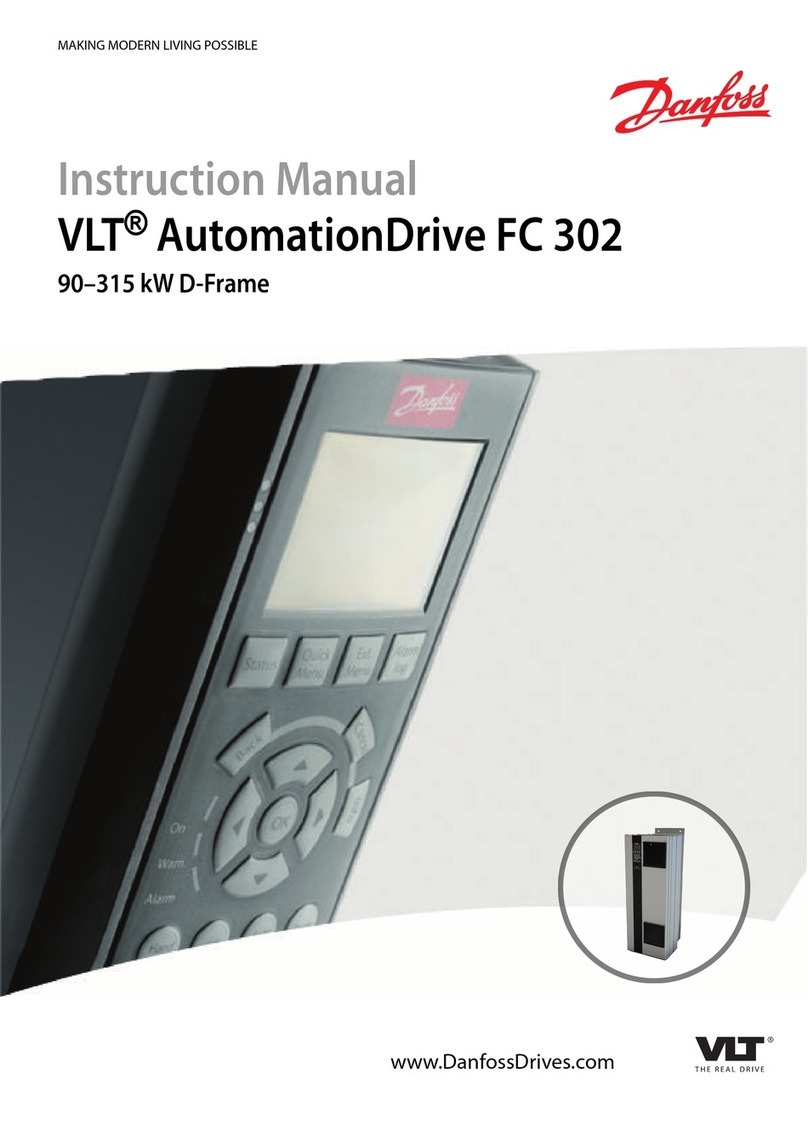
Danfoss
Danfoss VLT AutomationDrive FC 302 instruction manual

Lenovo
Lenovo ServeRAID M1215 Product guide
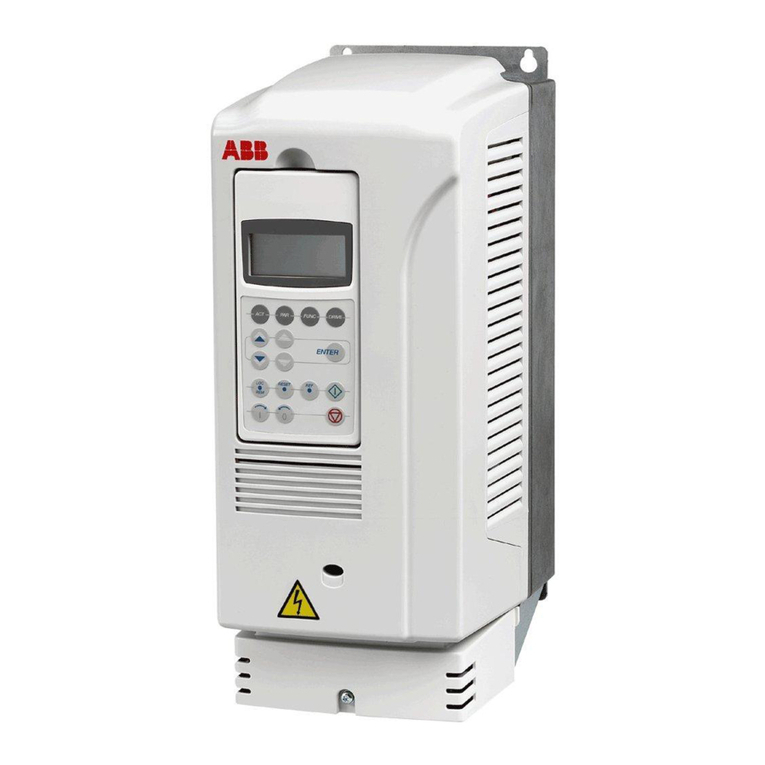
ABB
ABB ACS800-04 Hardware manual
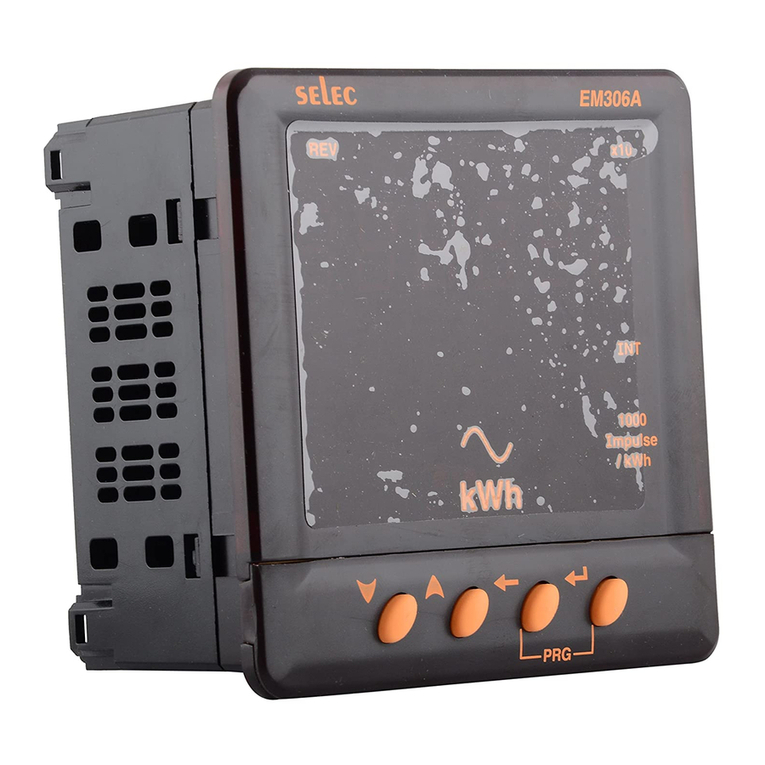
Selec
Selec EM306A operating instructions
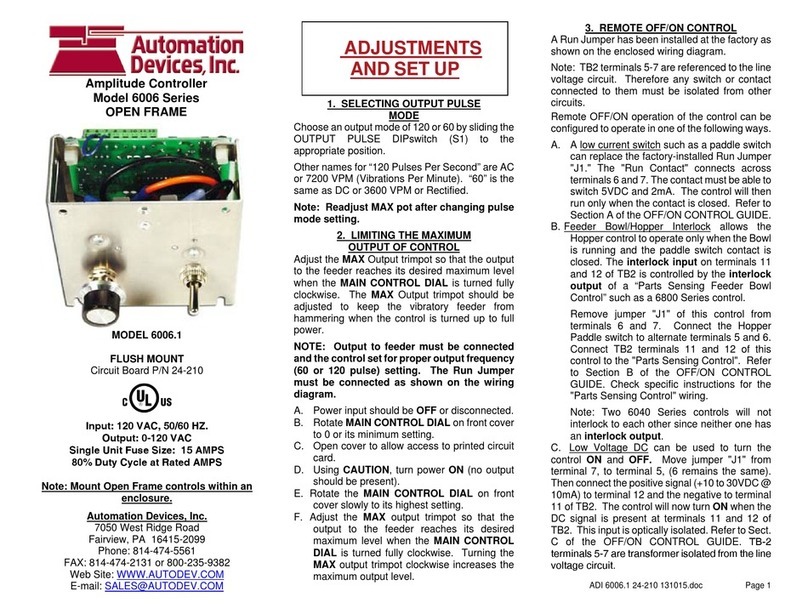
Automation Devices
Automation Devices 6006 Series Adjustments and Set Up
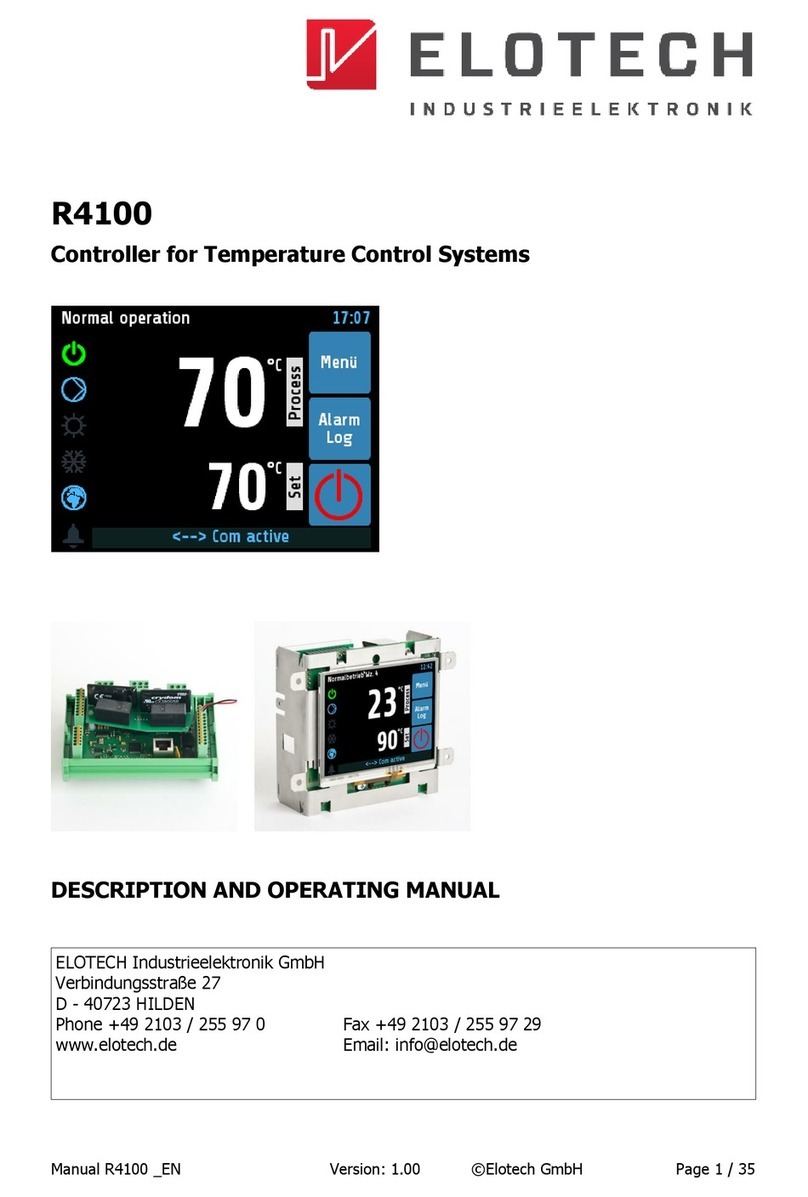
Elotech
Elotech R4100 Series Description and operating manual


